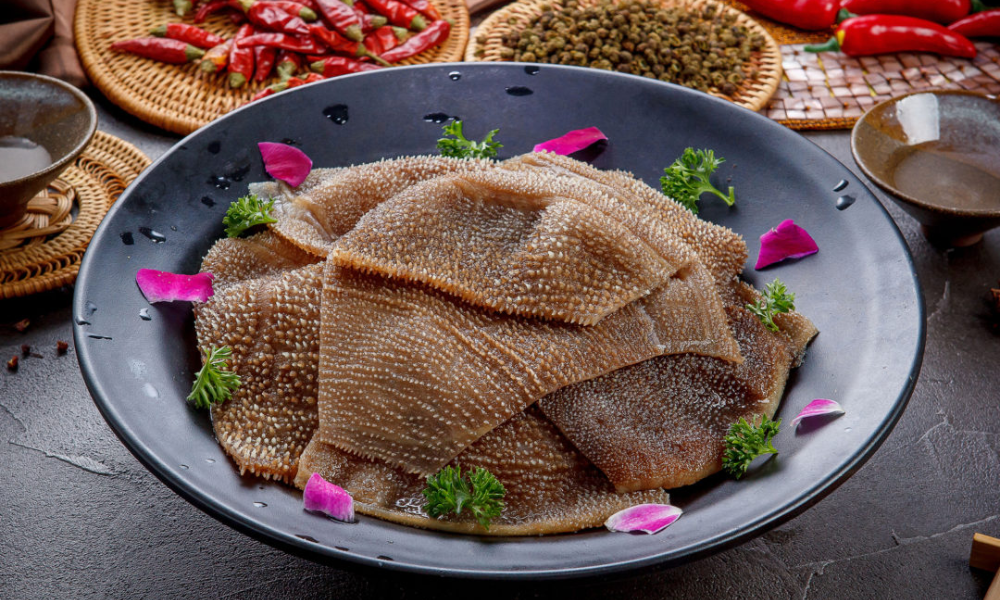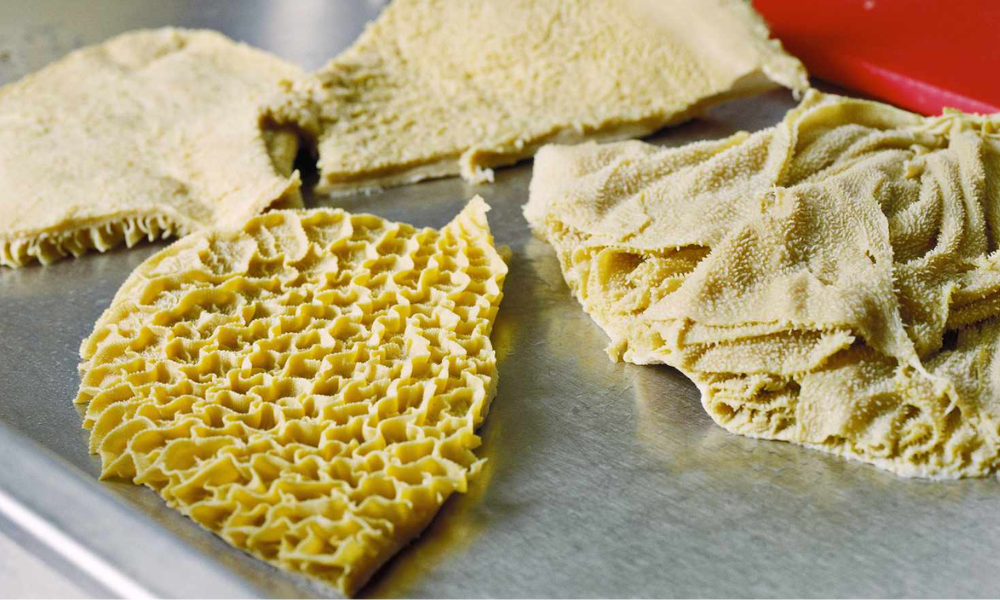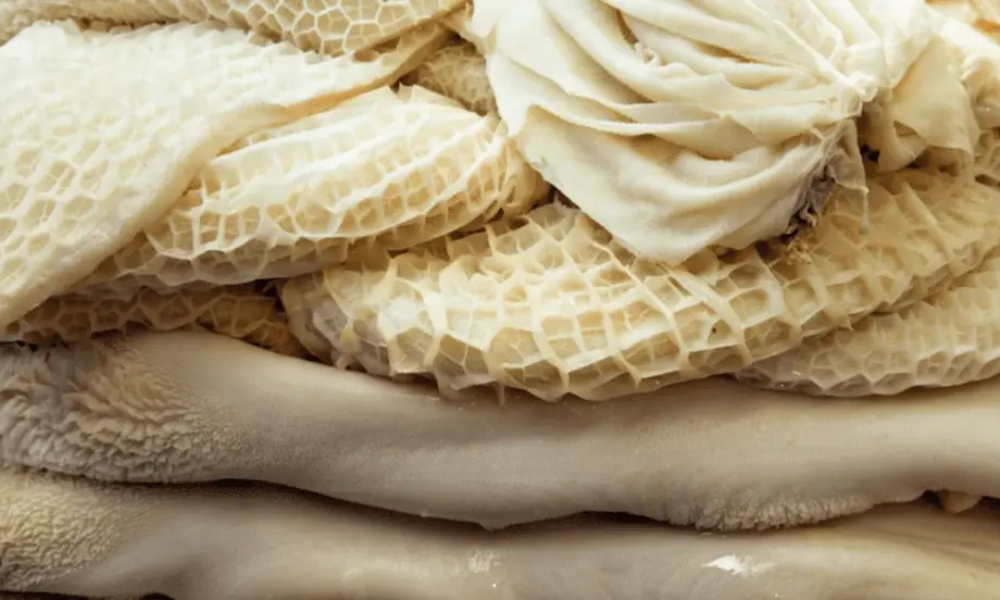Tripe is an organ meat that is a concentrated supply of nutrients and is used in many different countries’ traditional cuisines. Although they have been eaten since ancient times, organ meats have gained popularity due to the popularity of traditional eating habits like the paleo diet. The edible stomach lining of farm animals is used to make a sort of organ meat called tripe.
Everything you need to know about tripe, including its nutrition, potential advantages, and preparation, is covered in this article. Ruminant animals with several stomach chambers, including cows, buffalo, and sheep, can adequately digest their food. Cows and sheep are examples of ruminant animals, which are huge hoofed creatures with distinctive digestive systems.
What is Tripe?
Tripe refers to the edible lining or stomach of various animals, typically cattle or sheep. It is a type of offal or organ meat that has been consumed in different cultures around the world for centuries. It has a unique texture and flavor that some people enjoy, while others may find it less appealing.
There are several types of tripe, including:
- Blanket Tripe (Plain Tripe): This is the most common type, which comes from the first stomach of cattle or sheep. It has a smooth and pale appearance and a mild flavor.
- Honeycomb Tripe: It comes from the second stomach of cattle or sheep. It has a distinctive honeycomb-like pattern and a slightly chewy texture. Honeycomb tripe is often used in soups, stews, and braised dishes.
- Book Tripe: Book tripe is the third stomach of cattle or sheep. It has a smooth and flat appearance with a tender texture. Book tripe is commonly used in dishes like menudo or as a filling for dumplings.
Tripe needs to be cleaned thoroughly before cooking to remove any residual impurities and odor. It is often boiled or simmered for an extended period to tenderize it and remove any remaining undesirable flavors. It is commonly used in various cuisines, such as in traditional dishes like trippa alla Fiorentina (Italian), menudo (Mexican), or andouillette (French).
Is Tripe Good For Health?
It can provide some nutritional benefits, but it is not considered a particularly nutrient-dense food compared to other sources of lean protein. Here are some key points about the nutritional value:
Protein
Tripe is a good source of protein, which is important for building and repairing tissues, supporting immune function, and producing enzymes and hormones.
Vitamins and Minerals
It contains several vitamins and minerals, including vitamin B12, zinc, selenium, and iron. Vitamin B12 is essential for red blood cell production and neurological function, while zinc, selenium, and iron play important roles in various bodily processes.
Cholesterol and Fat
It can be relatively high in cholesterol and fat, depending on the specific type and preparation method. It is important to consider this if you are watching your cholesterol intake or following a low-fat diet.
Digestibility
Some people find tripe to be more easily digestible than other meats due to its unique composition and texture. However, individual tolerances and digestive sensitivities can vary.
What Does Tripe Taste Like?
The taste can vary depending on the specific type and preparation method, but it generally has a mild and slightly earthy flavor. The texture is often described as chewy and slightly rubbery. Some people may find it to have a subtle sweetness or a hint of gaminess.
The taste and texture can be influenced by the cooking techniques used. Boiling or simmering it for an extended period can help tenderize it and reduce any lingering undesirable flavors or odors. Tripe is often used as an ingredient in dishes where it absorbs the flavors of the accompanying ingredients and seasonings.
It’s worth noting that tripe is often appreciated for its texture and how it adds depth to dishes rather than being solely about its taste. Tripe is commonly used in stews, soups, and braised dishes, where it absorbs the flavors of the broth or sauce it is cooked in.
The perception of the taste can vary among individuals. Some people enjoy the unique flavor and texture of tripe, while others may find it less appealing. If you’re curious about trying tripe, it’s best to explore it in traditional dishes or consult with local culinary experts who can guide its preparation and flavor combinations.
How to Cook and Serve Tripe?
Tripe preparation and serving may appear difficult, but it’s fairly easy. Here are some preparation and enjoyment suggestions for this unusual ingredient:
Constructing Tripe
It needs to be well-cleaned before cooking. It is preferable to rinse tripe several times in cold water before boiling it because the flavor can be overpowering. To assist get rid of any lingering smell, you can also soak it in cold water for a few hours with a little vinegar or lemon juice.
Once it is clean, you can further purge it by boiling it in salted water for 10 to 15 minutes. After boiling, give it one last rinse in cold water before chopping it up for food.
Preparing Tripe
While there are many methods to prepare tripe, it is frequently boiled in a savory broth or stew. Here are some recipes and serving suggestions:
Tripe soup: For a substantial soup, simmer it in a broth with vegetables and herbs.
Tacos with tripe: Tacos with tripe, fresh cilantro, and lime. It is cooked with seasonings.
Curry made with tripe: Combine curry powder, coconut milk, and tripe to make a fiery curry.
Tripe stir-fry: For a quick and simple meal, stir-fry tripe with vegetables and soy sauce.
Consuming Tripe
The texture is unusual and can take some getting accustomed to, although many people like how chewy and rubbery it is. Here are some suggestions for serving:
Tripe can be fairly boring on its own, so it’s preferable to combine it with flavors that are robust, such as herbs, spices, and acidic foods.
Ensure simplicity: Tripe’s flavor and texture may shine in straightforward meals like soups and stews.
Don’t be hesitant to experiment with various slices of tripe because they all have somewhat different textures and flavors.
What Does Tripe Smell Like?
Tripe has a distinctive odor that can be described as slightly earthy or musky. Some people may find the smell to be slightly strong or pungent, while others may find it milder. The smell can vary depending on factors such as the specific type, its freshness, and how it has been cleaned and stored.
Fresh tripe should not have a foul or unpleasant odor. However, as it is an organ meat, it can have a somewhat unique smell that some individuals may find distinct or intense. It’s worth noting that the smell becomes more pronounced when it is raw or during the initial stages of cooking.
Proper cleaning and preparation can help reduce any lingering odors. Thoroughly rinsing it under cold water before cooking and removing any residual fat, impurities, or membranes can help minimize the smell. Additionally, cooking it with aromatic ingredients, such as herbs, spices, and vegetables, can help mask any undesirable odor and enhance the overall flavor of the dish.
If you find the smell to be off-putting or overly strong, it’s possible that it may not be to your taste. However, some people appreciate the unique aroma and flavor that tripe adds to certain dishes, particularly in traditional recipes and cuisines where it is commonly used.
As with any food, personal preferences and sensitivities to smells can vary among individuals. If you are unsure about the smell or concerned about the freshness, it’s advisable to rely on your senses and consider the overall quality before consuming it.
How to Store Tripe?
Storing it properly is important to maintain its freshness and prevent spoilage. Here are some guidelines for storing it:
Fresh
If you have purchased fresh tripe from a butcher or meat market, it should be stored in the refrigerator to keep it cool and inhibit bacterial growth.
Place it in an airtight container or wrap it tightly in plastic wrap or butcher paper to prevent it from drying out or absorbing odors from other foods. Fresh tripe can typically be stored in the refrigerator for up to 2 to 3 days.
Frozen
If you want to store it for a longer period, it can be frozen. It’s best to freeze it when it is still fresh. First, rinse it thoroughly under cold water to remove any impurities. Then, pat it dry with paper towels.
Next, portion it into suitable serving sizes or as per your needs. Place it in freezer-safe bags or airtight containers, removing as much air as possible to prevent freezer burn.
Label the packages with the date to keep track of their storage time. Frozen tripe can be stored for several months in the freezer, although the quality may begin to degrade over time.
Cooked
If you have cooked it and want to store the leftovers, allow it to cool completely before transferring it to an airtight container or airtight freezer bag.
It can be stored in the refrigerator for 2 to 3 days or frozen for longer-term storage. When reheating cooked tripe, ensure it is heated thoroughly to an internal temperature of 165°F (74°C) to ensure food safety.
Remember to always follow safe food handling practices and adhere to proper storage guidelines to prevent the risk of foodborne illnesses. If it develops an unusual odor, sliminess, or discoloration, it is best to discard it to avoid any potential health risks.
Conclusion
In conclusion, it is the edible lining or stomach of animals, typically cattle or sheep. It is commonly used in traditional dishes in different cuisines, and its flavor and texture can be an acquired taste. Some people enjoy the unique characteristics, while others may find it less appealing. If you are interested in trying tripe, it is advisable to explore traditional recipes or consult with local culinary experts for guidance on its preparation and incorporation into dishes.
As with any food, moderation, and balance are key. If you enjoy it and it fits into your dietary preferences and requirements, it can be enjoyed as part of a varied and balanced diet. However, if you have specific dietary restrictions, health concerns, or personal preferences, it is recommended to consult with a healthcare professional or registered dietitian for personalized guidance.


